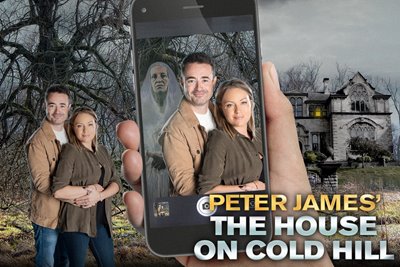
The House on Cold Hill sees Ollie and Caro Harcourt (Joe McFadden and Rita Simmons) move their family to an old manor house in the country, only to discover eerie presences in their new home. Adapted from Peter James’ novel of the same name, the leads provide a sympathetic and an engaging anchor for the supernatural drama, but they sadly can’t compensate for some misconceptions on how horror works on stage.
The big distinction here is the explicitly modern setting, with much emphasis put on how the supernatural elements interact with modern technology. This distinction also provides some humour to leaven the tension – you’d expect no less from a haunted Alexa – but it is not without drawbacks. Though it won’t affect a contemporary viewing, the singular focus on ghosts batting about on the wi-fi will surely date the play; I doubt it has legs in the long run. And the singular focus on digital equipment and brands quickly feels like a tiresome pitch to be ‘relevant’. A rapport with the audience is expected simply by virtue of the Harcourts owning the same crap we fill our own homes with. I would credit The House on Cold Hill with a subtle criticism on conspicuous consumerism if that played in any way into the drama. But it doesn’t.
That is the crux of my criticism. When you strip back the premise of The House on Cold Hill, there is no subtext, no subliminal theme to the drama. In the most iconic tales of horror, the creature or entity represents a pre-existing tension or trauma. Whether the terror is metaphorical or not within the narrative, the best scary stories draw on a deeper well of dark emotions. Here, everything exists on a very surface level. Early on we establish that there is a ghost, not a suggestion of hysteria, feverish delusion or hallucination. This sustains the story and tension for the first half ably enough but by the second half all that there is left to do is exposit on the origins of the ghost, which is neither interesting nor scary. It firmly switches the focus of the play from one of a family being terrorised to a triumphant struggle for resolution.
Scares are often foreshadowed by eerie music and sound spikes rather than letting silence build the tension. This sort of approach might work better for embellishing a red herring but it steals some of the power of the scares in practice. It is a bizarrely televisual approach to creating atmosphere which doesn’t really recognise the dynamics of horror on stage.
In all honesty, the first half is capable enough of entertaining and scaring the audience – beyond a cloying Blithe Spirit reference with a needless mystic – but by the second half the actors and shallow stage tricks can’t hide the fact that the story has failed to understand how fear works. ★★☆☆☆ Fenton Coulthurst 12th June 2019

